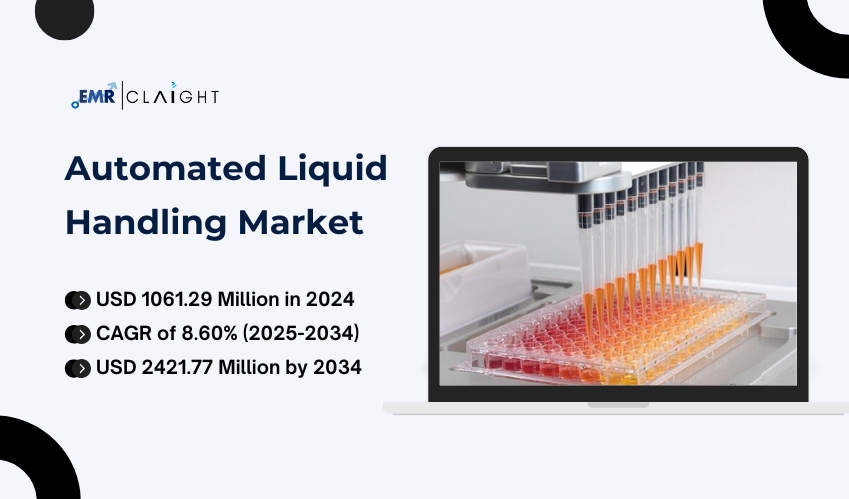
Automated Liquid Handling Market Outlook
The global automated liquid handling market attained a value of about USD 1061.29 million in 2024. Aided by the increasing demand for accuracy and efficiency in laboratory processes and the growing adoption of automation technologies in life sciences, the market is projected to grow at a CAGR of 8.60% between 2025 and 2034, reaching nearly USD 2421.77 million by 2034.
Automated liquid handling (ALH) systems are essential tools in modern laboratories, designed to manage the precise transfer of liquids across a wide array of applications including drug discovery, genomics, proteomics, and clinical diagnostics. These systems significantly reduce human error, increase throughput, and enhance reproducibility in experimental workflows. As laboratories around the world move toward high-throughput research and diagnostic testing, the role of automated liquid handling has become increasingly critical.
The shift toward personalized medicine, large-scale genetic analysis, and rapid development of biopharmaceuticals is further reinforcing the demand for sophisticated liquid handling solutions. The growing need for streamlined lab workflows, combined with a rise in the number of life sciences research projects globally, is expected to propel the market forward throughout the forecast period.
Automated Liquid Handling Market Size
The global automated liquid handling market has shown substantial growth in recent years and is expected to continue expanding due to the increasing integration of robotics and smart technologies in laboratory processes. As of 2024, the automated liquid handling market size reached a value of approximately USD 1061.29 million, supported by the widespread implementation of automation in pharmaceutical and biotechnology sectors.
The market size is bolstered by a growing focus on laboratory efficiency, especially in the wake of the COVID-19 pandemic, which highlighted the need for rapid diagnostic capabilities and accelerated drug development. High-throughput screening (HTS) laboratories and research institutions have been leading adopters of ALH systems, with many investing in advanced equipment to improve precision and save time in critical experiments.
As investments in life sciences and healthcare R&D continue to rise, particularly in emerging economies, the demand for automated liquid handling systems is expected to witness consistent and robust growth, increasing the global market size substantially by 2034.
Automated Liquid Handling Market Share
In terms of market share, North America currently dominates the global automated liquid handling market, owing to the presence of a well-established pharmaceutical industry, a strong base of academic research institutions, and early adoption of laboratory automation technologies. The United States, in particular, accounts for a significant portion of the regional market due to its large-scale investments in biomedical research and development.
Europe follows closely behind, with countries such as Germany, the United Kingdom, and France investing heavily in genomics and biotechnology. Asia-Pacific is rapidly emerging as a high-growth region, driven by expanding healthcare infrastructure, rising investments in R&D, and government initiatives promoting innovation in countries like China, Japan, and India.
Leading market players such as Tecan Group, Hamilton Company, Beckman Coulter (Danaher Corporation), Agilent Technologies, and PerkinElmer continue to hold prominent shares due to their advanced product portfolios, strong distribution networks, and emphasis on technological innovation.
Receive a detailed report, including the Table of Contents — https://www.expertmarketresearch.com/reports/automated-liquid-handling-market/requestsample
Automated Liquid Handling Market Trends
The automated liquid handling market is undergoing several transformative trends that are shaping its future growth trajectory. One of the most prominent trends is the integration of artificial intelligence (AI) and machine learning (ML) into automated systems. These technologies are enabling real-time data analysis, adaptive workflow adjustments, and predictive maintenance, thereby enhancing efficiency and minimizing system downtime.
Another key trend is the miniaturization of lab instruments and the rising demand for compact benchtop ALH systems. These systems are particularly suited for smaller laboratories with limited space and budget constraints but still require high precision and reproducibility in their workflows.
There is also a growing shift toward open and modular systems that can be easily customized based on specific research needs. This modularity allows laboratories to scale their operations flexibly, incorporating additional functionalities like barcode readers, heating/cooling modules, and integrated software interfaces.
In addition, sustainability is becoming an important consideration, with manufacturers designing eco-friendly liquid handling systems that minimize plastic waste, reduce reagent consumption, and operate with lower energy footprints.
Drivers of Growth
Several factors are driving the global automated liquid handling market growth. Chief among them is the increasing demand for high-throughput laboratory testing and diagnostics. With growing volumes of samples and the need for rapid turnaround times, automated systems are becoming indispensable in clinical laboratories and research centers.
The expansion of pharmaceutical R&D, especially in drug discovery and development, is another key growth driver. Automated liquid handling plays a critical role in enabling faster screening of drug candidates, optimizing compound management, and improving reproducibility in assays.
The rise of genomics and proteomics research has significantly contributed to market growth. These fields require precise pipetting and reagent handling across multiple microplates and assays, which can be efficiently managed through automation.
Additionally, the heightened awareness of laboratory safety and the need to reduce human error are prompting laboratories to adopt automated systems. Automated solutions help eliminate repetitive manual tasks, reduce operator fatigue, and ensure consistent results—factors that are especially important in regulated environments.
Moreover, government support and funding for life science research, particularly in the fields of oncology, neuroscience, and infectious diseases, are encouraging institutions to invest in state-of-the-art liquid handling equipment.
Automated Liquid Handling Market Segmentation
The market can be divided based on type, modality, procedure, end user and region.
Breakup by Type
- Standalone
- Individual Benchtop Workstations
- Multi Instrument
- Others
Breakup by Modality
- Disposable Tips
- Fixed Tips
Breakup by Procedure
- Serial Dilution
- Plate Reformatting
- Plate Replication
- PCR Setup
- High Throughput Screening
- Cell Culture
- Whole Genome Amplification
- Array Printing
- Others
Breakup by End User
- Biotechnology and Pharmaceutical Companies
- Contract Research Organisations
- Academic and Government Research Institutes
Breakup by Region
- North America
- Europe
- Asia Pacific
- Latin America
- Middle East and Africa
Competitive Landscape
Some of the major players explored in the report by Expert Market Research are as follows:
- Agilent Technologies, Inc.
- Hamilton Company
- Aurora Biomed Inc.
- Biotix, Inc.
- Gilson, Inc.
- Others
Challenges and Opportunities
Despite its promising growth, the automated liquid handling market faces several challenges. High capital costs associated with acquiring and maintaining ALH systems can be a deterrent for small and medium-sized laboratories. The complexity of some systems also requires skilled personnel for setup and operation, posing a challenge for labs lacking technical expertise.
Compatibility issues between various automated platforms and legacy laboratory equipment can hinder seamless workflow integration. Additionally, concerns related to system downtime and software malfunctions can impact the efficiency and reliability of lab operations.
Nevertheless, the market presents considerable opportunities. The growing adoption of cloud-based platforms and the Internet of Things (IoT) in laboratory settings is opening up new avenues for remote monitoring, centralized data management, and enhanced system connectivity. This digital transformation is expected to redefine laboratory automation and provide a competitive edge to companies offering integrated digital solutions.
Another significant opportunity lies in emerging markets, where governments are increasingly investing in healthcare infrastructure and research capabilities. As local industries expand and laboratory standards evolve, demand for automated liquid handling solutions in these regions is anticipated to surge.
Furthermore, the development of user-friendly, plug-and-play systems is lowering the entry barrier for small labs and startups, allowing them to benefit from automation without extensive training or customization.
Automated Liquid Handling Market Forecast
The global automated liquid handling market is set to maintain strong growth momentum throughout the forecast period of 2025-2034. Projected to expand at a CAGR of 8.60%, the market is expected to reach a value of nearly USD 2421.77 million by 2034. This growth will be supported by ongoing technological advancements, increasing research activities in life sciences, and the continuing need for efficient, scalable, and reliable laboratory solutions.
As the landscape of laboratory research and diagnostics becomes increasingly complex, the role of automated systems will continue to grow. Companies that invest in innovation, user-centric design, and digital integration will be well-positioned to lead the market. With expanding applications across biopharmaceuticals, diagnostics, academic research, and clinical laboratories, the automated liquid handling market is poised to play a vital role in shaping the future of laboratory automation and precision science.
Media Contact:
Company Name: Claight Corporation
Email: sales@expertmarketresearch.com
Toll Free Number: +1-415-325-5166 | +44-702-402-5790
Address: 30 North Gould Street, Sheridan, WY 82801, USA
Website: https://www.expertmarketresearch.com


